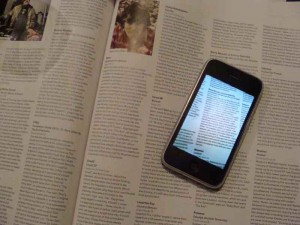The presentation of text to a reader has transformed over time, taking many forms including inscriptions on clay tablets, illuminated manuscripts, the birth of the daily newspaper, magazines and today’s online platforms.
 This fluid and dynamic evolution has been largely shaped by the changing nature of readerships. The constant thread to these approaches is the recognition that reading is a key social practice, a practice that regardless of medium is integral to our lives.
This fluid and dynamic evolution has been largely shaped by the changing nature of readerships. The constant thread to these approaches is the recognition that reading is a key social practice, a practice that regardless of medium is integral to our lives.
Recent shifts in readerships have been acknowledged by publishers moving to the online environment. Traditionally the role of the publisher is to present the text and the task of the reader is simply to read. The rise of digital natives and cultures has seen a shift in these established roles with reading practices becoming much more participatory and responsive. The online environment challenges the role of the reader; text is not presented as stagnant matter, it is fluid and interactive – pushing the reader to engage. Digital audiences can question relevance and hierarchy of information thus rejecting conventions of traditional publishing. Texts can be forwarded, commented on, re-mixed and republished based on the engagement of the reader. The reader can now become their own publisher.
In this way reading becomes an interactive experience allowing literary audiences to shape and control the process, selecting text and information relevant to individual needs.
Although the online environment may never replace the printed edition completely, I believe they can exist to compliment each other and play into different readers preferences. While the presentation of text online may not suit all readers, there is still great value in traditional publishing conventions. There will always be tactile readers who will choose a bound printed edition to hold in their hands. These readers may associate reading as a solitary practice and one that plays into other social practices including archiving the written word. Other readers may delight in instant specific access to information and the ability to shape this text. Some readers will view the bound volume as a trusted source and others will delight in the ability to interact with texts and self publish.
‘Reading means approaching something that is just coming into being’. Italo Calvino
The idea of reader’s shaping content is not new and similarities can be seen between historical texts and digital publications. For example The Oxford Dictionary, a text held in high regard in academe, was created via an open call for submissions from the public. Likewise Wikipedia, a widely utilised online resource welcomes user content and submissions. Perhaps it can be said that traditional publishing takes the reader into consideration at an earlier stage and that digital publishers provide an end product open to a dialogue with readers.
Publishing should be a conversation – a fluid discourse that exists between publishers and readers to provide the written word in ways that match the preferences of their readership. Be this online, printed or future unimaginable forms.
Megan Patty
Megan Patty is Melbourne based writer with an interest in emerging practices. Published internationally she has a penchant for grammar, media art and the first cherry blossoms of Spring.
Read More
Italo Calvino, If on a winters night a traveller, Harvest Books, 1979.
Alberto Manguel, A history of reading, Penguin Books, 1997.
Simon Winchester, The surgeon of Crowthorne: A tale of murder, madness and the love of words, Penguin Books, 1999.
 This work is licensed under a Creative Commons Attribution-NonCommercial-ShareAlike 3.0 Unported.
This work is licensed under a Creative Commons Attribution-NonCommercial-ShareAlike 3.0 Unported.






